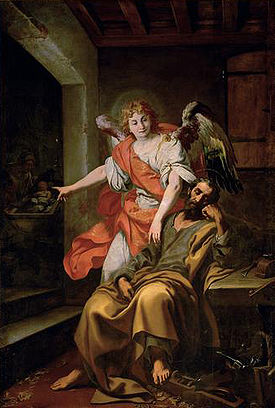
Daniele Crespi
Encyclopedia


Daniele Crespi was an Italian
Italy
Italy , officially the Italian Republic languages]] under the European Charter for Regional or Minority Languages. In each of these, Italy's official name is as follows:;;;;;;;;), is a unitary parliamentary republic in South-Central Europe. To the north it borders France, Switzerland, Austria and...
painter of the Baroque
Baroque
The Baroque is a period and the style that used exaggerated motion and clear, easily interpreted detail to produce drama, tension, exuberance, and grandeur in sculpture, painting, literature, dance, and music...
era. He was born in Busto Arsizio
Busto Arsizio
Busto Arsizio is a city and comune in the region of Lombardy, in northern Italy, 25 km north of Milan in the province of Varese.The economy of Busto Arsizio is mainly based on industry and commerce.-History:...
, and active mostly in the Milan
Milan
Milan is the second-largest city in Italy and the capital city of the region of Lombardy and of the province of Milan. The city proper has a population of about 1.3 million, while its urban area, roughly coinciding with its administrative province and the bordering Province of Monza and Brianza ,...
of Federico Borromeo
Federico Borromeo
Federico Borromeo was an Italian ecclesiastic, cardinal and archbishop of Milan.-Biography:Federico Borromeo was born in Milan as the second son of Giulio Cesare Borromeo, Count of Arona, and Margherita Trivulzio...
.
A student of Giovanni Battista Crespi
Giovanni Battista Crespi
Giovanni Battista Crespi , called Il Cerano, was an Italian painter, sculptor, and architect,-Biography:...
and Giulio Cesare Procaccini
Giulio Cesare Procaccini
Giulio Cesare Procaccini was an Italian painter and sculptor of the early Baroque era in Milan.-Biography:Born in Bologna he was son of the Mannerist painter Ercole Procaccini the Elder and brother of Camillo Procaccini and Carlo Antonio Procaccini...
, he was an excellent colorist, known for the simplistic beauty of his composition. His earliest works show him assisting Guglielmo Caccia
Guglielmo Caccia
Guglielmo Caccia called il Moncalvo was an Italian painter who specialised in altar-pieces.He was born in Montabone near Acqui. He said to have been a pupil of Lorenzo Sabbatini. He started painting in Milan, then worked in Pavia, where he was made a citizen...
in San Vittore. His best works include a series of pictures from the life of Saint Bruno
Bruno
Bruno is a male given name. It is derived from the Germanic word brun meaning "brown". It is also one of the most frequent Italian surnames. It also occurs very frequently in continental Europe and parts of Brazil as a given name for men and boys...
(now in the Certosa di Garegnano in Milan) and a depiction of the Stoning of St. Stephen (in Brera
Brera
Brera is a district of Milan, ItalyBrera may also refer to:* the Palazzo Brera, a historical building in Brera; the palace also houses:** the Brera Art Academy** the Brera Art Gallery** the Brera Astronomical Observatory...
). Another masterpiece is the dark 1628 San Carlo Borromeo at Supper in the church of Santa Maria della Passione in Milan. Other works by him can be found in Milan and Pavia
Pavia
Pavia , the ancient Ticinum, is a town and comune of south-western Lombardy, northern Italy, 35 km south of Milan on the lower Ticino river near its confluence with the Po. It is the capital of the province of Pavia. It has a population of c. 71,000...
. His Conversion of Saint Paul, when compared to Caravaggio's earlier work
Conversion on the Way to Damascus
The Conversion on the Way to Damascus is a masterpiece by Caravaggio, painted in 1601 for the Cerasi Chapel of the church of Santa Maria del Popolo, in Rome. Across the chapel is a second Caravaggio painting depicting the inverted Crucifixion of St. Peter...
in the Cerasi Chapel
Cerasi Chapel
The Cerasi Chapel is one of five chapels located within the Church of Santa Maria del Popolo in Rome. It contains important paintings by Michelangelo Merisi da Caravaggio and Annibale Carracci, two of the founders of Baroque art, all dating from 1600 or 1601.The chapel was purchased in July 1600...
, shows the persistence of Crespi's Mannerist
Mannerism
Mannerism is a period of European art that emerged from the later years of the Italian High Renaissance around 1520. It lasted until about 1580 in Italy, when a more Baroque style began to replace it, but Northern Mannerism continued into the early 17th century throughout much of Europe...
traits. Crespi died in Milan during the plague epidemic
Bubonic plague
Plague is a deadly infectious disease that is caused by the enterobacteria Yersinia pestis, named after the French-Swiss bacteriologist Alexandre Yersin. Primarily carried by rodents and spread to humans via fleas, the disease is notorious throughout history, due to the unrivaled scale of death...
in 1630.

